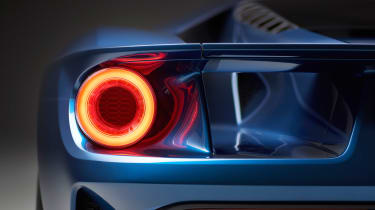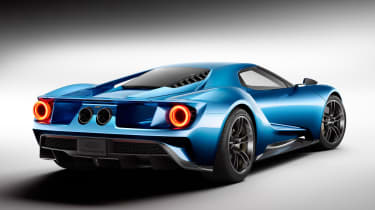Ford GT: Everything we know about Ford's supercar
The Ford GT supercar gets a 638bhp twin-turbocharged V6, can do 216mph and costs £320,000, but production is already sold out for 2017
It's hard to think of another supercar that's as hotly anticipated as the new Ford GT. While the car was revealed over two years ago at the Detroit Motor Show, only now are first customers getting delivery of their 200mph+ supercars.
Considering the bespoke nature of thr Ford GT, it's no surprise there has been a bit of a wait. The GT follows in the footsteps of the Ford GT of the Noughties, and of course the legendary GT40 of the Sixties, and has a traditional mid-engined, two-seater layout.
Less traditional is the fact Ford has taken a different route with engine choice. While plonking a V8 in the back would've been the obvious option, Ford has picked a 3.5-litre twin-turbo V6 EcoBoost instead. It makes a healthy 638bhp, and when you combine this with an advanced carbon fibre and aluminium construction that keeps wight around the 1,400kg mark (slightly more than a Ford Focus), it means the lightweight Ford GT has a top speed of 216mph.
But top speed isn't the only thing the GT will be good for, as active aerodynamics, race-inspired pushrod suspension and track-honed settings, and the fast Ford should be a strong rival against models such as the Audi R8, Ferrari 488 GTB, Honda NSX and new McLaren 720S. Indeed, the GT has already proved its potential at the track in endurance racing, winning the GT class in the 2016 Le Mans 24 Hours and a number of other events across the world.
The Ford GT has been designed as a flagship for the Ford range, and it shows in its design. The clean shape is a clear evolution of the original Ford GT, but it lacks the retro touches that car used in its shape. The angular lines are thoroughly modern and are designed to help the GT cut through the air with minimal resistance. The dihedral doors add drama when getting in and out, and the gaping air intakes and vents are designed to maximise airflow to cool the powerful engine.
One distinct difference between the Ford GT and its rivals is the exclusivity the new Ford offers. Only 250 cars will be built each year, and production is planned to 2020, although even then demand is outstripping supply, and that's even with a $400,000 (£320,000) price tag for the basic model.
Ford GT: Lightweight Competition Series model breaks cover
The New Ford GT has already spawned a limited edition version, with the reveal of the lightweight GT Competition Series – an exclusive model boasting weight saving measures and unique design tweaks.
The GT Competition Series still boasts the same 638bhp turbocharged V6 engine and mechanicals as the regular GT, but the engine is now shrouded away from the elements by a lightweight, track inspired Perspex engine cover with a carbon-fibre prop-rod.
Similarly, the Gorilla glass bulkhead window in the cabin, separating driver from engine, is about half as thick as it is on the standard GT model. Further weight savings are found by ditching what Ford labels “items not essential to performance”, such as the air-conditioning unit, radio and speakers, stowage bins and even cupholders.
The Competition Series GT gets additional performance oriented standard equipment too, such as carbon-fibre wheels with lightweight titanium wheel-nuts – optional on the regular car.
It’s marked out against the regular GT with a carbon-fibre finish racing stripe, mirror caps and A-pillars, while an exposed carbon finish is used on some of the lower body trim. A price has not been revealed, and it'll be limited to the US market only.
Ford GT: New Digital Instrument Display revealed
The Ford GT will get an all-new ‘Digital Instrument Display’ featuring unique, setup dependent layouts – and the company has confirmed the technology will be coming to other Ford vehicles in the future.
Replacing the instrument cluster, the 10-inch setup is not too dissimilar from Audi’s Virtual Cockpit technology. It boasts configurable layouts based on the GT’s five driving modes, each one tailored to deliver the most relevant information depending on which mode the driver has selected.
In normal mode, the Digital Instrument Panel afford equal weight to most of the information in a simple theme, while wet mode puts a blue tint on the instruments, with wet look graphics.
Sport mode shifts the information around so that the gear selection is placed front and centre with speed placed off to the right hand side of the tachometer and ushers in an orange theme. It’s similar to track mode, which takes on a red hue but hides speed in the top left corner – vitals such as oil temperature and pressure are given more prominence.
The final layout is one tailored for drivers gunning for the GT’s 216mph top speed. Called V-Max, it de-clutters the instrument panel and pares everything back, so that the focus is almost entirely on a large, central speedometer. The tachometer is reduced to a thin line, while fuel, oil pressure and temperature is tucked away in the top left.
For now, the Digital Instrument Display technology will only be heading the way of those lucky enough to get on the waiting list for the GT. However, Ford has confirmed it will trickle down onto other models in the future.
Ford GT: Five driving modes in detail
The new GT wouldn’t be a modern supercar without adjustable driving modes, and Ford has packed five different selectable setups into its new flagship machine.
In Normal mode, the GT rides with 120mm of ground clearance, while traction control and stability control systems are locked on. The rear wing pops up at 90mph, though even in this Normal setting it can still be deployed as an airbrake if the pedal is slammed on at speed. Wet mode is the same as Normal, but lowers throttle sensitivity and responsiveness. With both of these modes activated, comfort suspension settings are available.
Sport mode is billed as a setup that can be used on road and track. When selected, throttle response is sharper and the car’s anti-lag system works harder to eliminate turbo-lag. Traction control settings become adjustable too, so the driver can experiment with the level of electronic intervention. Track mode builds on this by reducing the ride height to 70mm, adjusting the dampers and springs to their firmest settings, and automatically deploying the rear wing while closing the two active aero flaps at the front, for maximum downforce.
The final driving mode is called V-Max, and it’s all about straight-line performance. Active aerodynamic parts are positioned for minimal drag, the ride height remains 70mm, and stability controls remain on in anticipation of high-speeds. It can only be activated when the car is stationary, and can be used in tandem with launch control.
Ford GT: Production of new supercar begins
The first production model of the all-new Ford GT has rolled off the assembly line and is heading to an excited customer. The first car rolling off the line marks the start of the all-new supercar's production run. The Ford GT will be built over a span of four years, with production having been extended due to huge demand.
Originally just 500 examples of the Ford GT were set to be built, which meant that a lot of interested customers would miss out. With the production length now doubled, it's expected another 500 lucky punters (meticulously selected by Ford, of course) will be able to update their applications to buy one.
The decision comes on the back of a commitment by Ford Performance to race the GT in both the IMSA and WEC (World Endurance Championship) Series for four years.
Dave Pericak, Global Director of Ford Performance, says “While we can’t build enough Ford GTs for everyone who has applied, we are going to produce additional vehicles in an effort to satisfy more of our most loyal Ford ambassadors.”
Year three of production will support those who were already sat on the existing waiting list, while applications will open for year four's allowance in early 2018.
Following its Le Mans class win, Ford will be offering the first year’s production with an optional Le Mans heritage colour scheme. Not the 2016 racing colours though, but the black and silver-striped paintjob from the Ford GT40 which won Le Mans in 1966.
In addition, Ford has revealed the GT will be available in eight 'bright' colours, as well as various themes that aim to co-ordinate things like the interior and racing stripes. Personalisation is key, though, with owners offered the chance to upgrade items such as the brake calipers – which are available in silver, blue, orange and red.
Ford Design Manager Barb Whalen said: "We walked a fine line with the colour and materials in this vehicle – infusing energy through use of colour and balance while working to ensure the raw appeal of a performance car still shines through. Everything in the Ford GT was intentionally designed to express ultimate performance.”
Carbon fibre will feature heavily both inside and out – serving as a 'visual anchor' of the car's lightwight construction. Buyers will be able to spec gloss, matt or Shadow Black paint for the exposed carbon fibre parts dotted around the cabin.
The order books for the Ford GT were originally opened and closed in just a few weeks in 2016, when Ford received more than 6,500 applications from would-be owners.
There are 500 UK applicants on the list so far, but that's likely to change now. However, we do know that purchasers of the last Ford GT will be bumped to the top of the list: "We want to prioritise people who are going to care about the car, keep the car, and drive the car," the company says.
The Ford GT was revealed at the Detroit Show in January 2015, and made its European show debut at Geneva in March the same year. Despite order books being full, there's no official word on when UK deliveries will begin, although mid-2017 seems likely.
With 638bhp, stunning aero-inspired looks and a $400,000 price tag, it's no surprise that there are so many would-be buyers. Read on for more details about the amazing Ford supercar.
Ford GT: design secrets
We went behind the scenes at Ford's HQ in Dearborn, Michigan to learn more about how the Ford GT was born, and how the brand managed to keep it under wraps for so long before its Detroit debut
First US customers have only just received theirs, but it's already been out on Michigan plates being put through its paces for a while. Ford is aware there's no point in disguising now its been seen by the world, so a vicious-looking matt grey paintjob is the only attempt at camouflage.
That low, wedgy stance is clearer than ever amongst the SUV-heavy Michican streets, as are the enormous flying buttresses, rakish rear end and aerodynamic body slits. It's Ford's second attempt at a modern take on the retro GT40 Le Mans racer of the 1960s.
We know that the GT sports a mid-mounted twin-turbo 3.5-litre V6 EcoBoost engine, and is combined with a seven-speed dual clutch automatic gearbox. The body is made primarily from carbon-fibre, and Ford promises "one of the best power-to-weight ratios of any production car".
The tale behind this reinvented American icon goes back a little further, so we visited Ford’s headquarters in Dearborn, Michigan, to get the full behind-the-scenes story.
The Ford GT project was so secret that it was designed by a tiny team of people, and they didn't work in one of the many studios in the vast Ford Design Center, but in a windowless basement corner room protected by a padlock.
2016 Ford GT: new from the ground up
From the beginning, the brief was to make something different to the 2005 Ford GT, which used aluminium and magnesium components and a 550bhp 5.4-litre supercharged V8. An early decision was made to construct it from lightweight carbon-fibre structural and body panels, with a rear-mounted, twin-turbo 3.5-litre V6 producing more 638bhp.
This engine couldn’t be further from an old-school V8. Stephen Russ, director of global engine engineering, explained that the GT’s ECU processes 3,000 signals from 50 sensors around the car and uses 28 microprocessors running 10million lines of code (an F22 military plane uses two million lines, and a Boeing 787 six million).
New Ford GT: a top secret programme
Only a handful of people were aware of the program. These included top management, like chief designer Moray Callum, exterior design chief Craig Metros and global interior design boss Amko Leenarts, plus the Ford Performance team, including director Dave Pericak and chief engineer Jamal Hameedi.
Standing at the entrance to the design bunker surrounded by sketches and scale models, Callum told us: “This room housed one of the first mills that ever came into Ford Motor Company. We took this space, moved everything out of it and refurbished. Not only did the space have to be different, but the process had to be different, too.
“We mixed a couple of young designers with more experienced ones. We wanted fresh ideas from the youngsters, but knew we needed the experienced guys to get the car done in a record time of 14 months.”
Ford GT styling and design details
Despite the dramatic styling details on the GT, the low stance and profile is instantly recognisable to fans of its predecessors. There's 20-inch wheels clad in Michelin Pilot Super Sport Cup tyres, and the suspension is a torsion bar and pushrod set-up that is height-adjustable. Carbon-ceramic brakes are also standard.
Callum said the team used the traditional method of doing a two-dimensional sketch of the car and moving on to scale models carved from foam using mathematical data. This lightweight foam made it easier to move the models outside to view them in natural light.
Plus, he added that the ducting and venting on the body, the flying buttresses and the teardrop shape of the fuselage behind the cockpit were all tested and proven in the wind tunnel. Ford Performance chief engineer Hameedi talked about the breathtaking shape of the car: “The tapering fuselage comes from a Formula One or an LMP1 car. They all have a taper, which sets up a very clean air path to the rear wing, and that’s what we’re doing here.”
He added that the team worked hard to not only get a low coefficient of drag (Cd), but a low CdA figure, too. This is the Cd multiplied by the frontal area of the car – an indicator of the aero drag that must be overcome to achieve both speed and stability.
“One of the goals was to have a small greenhouse [upper section of the body] to get a world-class CdA number,” Hameedi said. “Air coming around the surface does not detach. It’s been carefully crafted and designed to have clean laminar flow.”
Elizabeth Baron and her team used Ford’s virtual design studio to build a complete interior and exterior of the GT from computer data that engineers and designers could get into and sit down in. There they could explore the spatial relationships in the narrow cockpit by donning a special stereo viewing helmet and using a wand and a “flashlight” to look at elements in detail.
Amko Leenarts, who led the interior design, said: “When you have a special package, and this was a special package, engineering and design have to go hand-in-hand. In this car, there was no big centre console with a big shifter, because we had to be as lean and efficient as possible.
“We designed it so the steering column and pedals come to the driver. Because of the hyper-small space, we needed to carve out a lot of space from the dash to get a lightweight feel. When you get into the car, you get an immediate feel of raciness. All the functions are on the steering wheel.”
The Ford GT road car is the most sophisticated, fastest and most expensive car ever to wear the famous blue oval badge.
Would you prefer a Ford GT or a Lamborghini Aventador? Let us know in the comments section below...
Find a car with the experts













